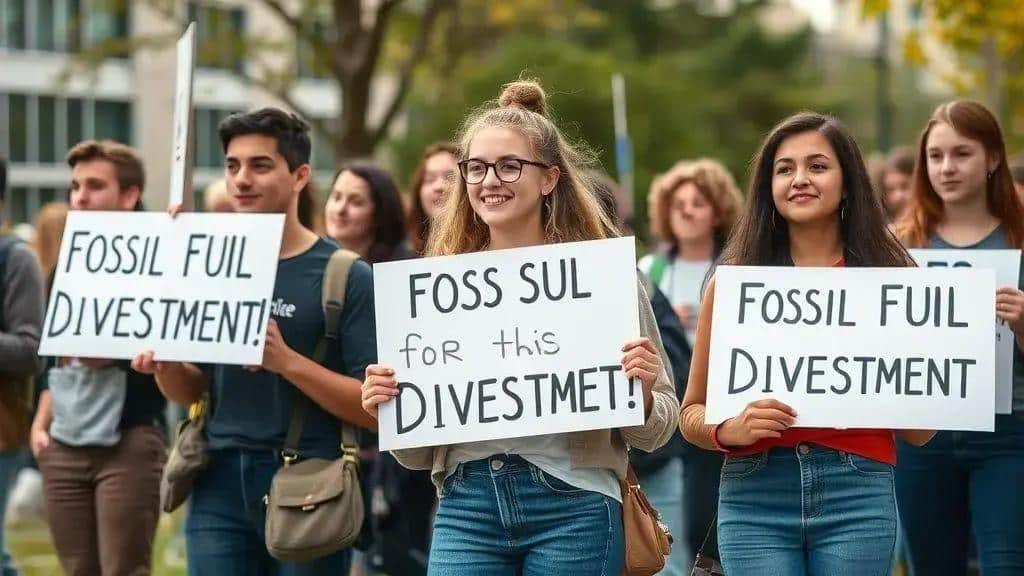Fossil fuel divestment in public schools: a crucial shift

Fossil fuel divestment in public schools involves selling investments in fossil fuel companies to support renewable energy initiatives, promote environmental responsibility, and engage students in sustainability efforts.
Fossil fuel divestment in public schools is becoming a significant movement, sparking conversations about environmental responsibility and financial ethics. Have you considered how such decisions shape the future of education and our planet?
Understanding fossil fuel divestment
Understanding fossil fuel divestment is essential in today’s conversation about climate change and sustainability. Schools are starting to rethink their financial ties to fossil fuel companies. This shift can impact not just how schools operate financially, but also how students think about their role in the environment.
What is fossil fuel divestment?
Fossil fuel divestment means selling off investments in companies that produce oil, gas, and coal. This practice is designed to encourage organizations, including schools, to focus on renewable energy sources. By divesting, schools are supporting a green future and reducing reliance on harmful fossil fuels.
Reasons for divestment
- Environmental responsibility: Schools want to lead by example.
- Financial stability: Fossil fuels can be a risky investment.
- Student activism: Young people are passionate about climate change.
As fossil fuel divestment spreads, many educational institutions participate in this critical movement. Schools aim to not only invest in their students but also their planet. Investment in renewable energy enhances education on sustainability. By teaching students about green alternatives, schools can inspire future generations.
Additionally, even though divestment can seem overwhelming, many institutions show that it is achievable. Establishing policies that favor sustainable investments helps pave the way for future decisions. Students become involved, asking for changes and pushing for greener initiatives.
Many campuses are becoming examples of eco-friendliness, paving the way for a broad movement. Students learn that their choices matter and that they can influence larger systems.
The impact on school funding

The impact on school funding due to fossil fuel divestment is an important topic to explore. When schools choose to divest from fossil fuels, they often make significant changes to how they allocate resources and manage their budgets.
Potential benefits of divestment
By divesting, schools can redirect funds towards sustainable initiatives. This includes projects focused on renewable energy and environmental education. These investments not only benefit the educational community but also promote a healthier planet.
Challenges faced
- Initial costs: Transitioning can be expensive.
- Uncertain financial returns: Schools may worry about lower returns on investment.
- Resistance from traditional stakeholders: Some may oppose the shift towards renewables.
Despite these challenges, many schools find that divesting can lead to long-term financial benefits. It may attract new funding sources, including grants for renewable energy projects. Furthermore, as societies shift towards greener solutions, schools may find that their eco-friendly policies enhance their reputation and draw in more students.
Additionally, when schools openly embrace fossil fuel divestment, they attract attention from potential donors and partners interested in supporting environmental responsibility. Students and parents often feel pride in supporting institutions that prioritize sustainable practices.
This movement towards a sustainable future may prompt schools to innovate further, seeking out unique funding opportunities while educating students on the importance of environmental stewardship. By prioritizing these changes, schools can emerge as leaders in sustainability and financial responsibility.
How schools are making the transition
Schools are increasingly focusing on how making the transition away from fossil fuels affects their future. Shifting to sustainable practices allows schools to lead by example and prepare students for a greener world.
Steps schools are taking
Transitioning involves multiple strategies. Many schools start by assessing their current investments. This helps identify which areas need immediate action. Afterward, they can develop a clear plan to divest from fossil fuels.
Partnering with experts
- Hiring consultants to guide the transition.
- Collaborating with environmental organizations for support.
- Engaging students and faculty in the decision-making process.
Engaging the school community is vital. Students can organize events to raise awareness about the benefits of divestment. Moreover, teachers can incorporate sustainability into the curriculum, fostering a culture of environmental responsibility.
Some schools implement measurable goals to track their progress in sustainability. For example, they may aim to reduce carbon footprints by specific percentages within certain time frames. Additionally, schools often seek funding from government incentives and grants to support their transition.
Transforming spaces also plays a part. Schools redesign facilities to include energy-efficient systems and utilize renewable energy sources. Solar panels, rain gardens, and green roofs are becoming more common. These changes not only enhance the learning environment but also serve as teaching tools.
Student activism and engagement

Student activism and engagement play crucial roles in the movement toward fossil fuel divestment in schools. Students are passionate advocates for change and have the power to influence school policies.
Ways students are getting involved
Many students organize campaigns to raise awareness about the importance of divesting from fossil fuels. They host events, create petitions, and engage their peers in discussions. By collaborating with environmental organizations, they amplify their voices and reach a wider audience.
Building a supportive community
- Creating clubs focused on sustainability.
- Partnering with teachers and staff for joint initiatives.
- Engaging with the administration to present ideas.
Students often work alongside faculty to incorporate sustainability curricula, bridging the gap between education and activism. This partnership empowers students to take action while learning about environmental issues.
Additionally, student-led demonstrations and public forums bring attention to fossil fuel divestment. These activities encourage students from different backgrounds to participate, fostering a sense of unity and purpose.
Through social media campaigns, students can share their messages and accomplishments widely. They use platforms to spread awareness, encouraging others to join the cause. This online presence can significantly influence local and national conversations about climate change and sustainability.
Student engagement in the divestment movement fosters a sense of responsibility and leadership. When young people feel heard and appreciated, they are more likely to commit to future initiatives. This engagement not only impacts their school environment but also prepares them to be thoughtful stewards of the planet.
FAQ – Frequently Asked Questions about Fossil Fuel Divestment in Schools
What does fossil fuel divestment mean for schools?
Fossil fuel divestment means that schools sell off their investments in companies that produce oil, gas, and coal, focusing instead on sustainable and renewable energy.
How can students get involved in the divestment movement?
Students can organize campaigns, create petitions, engage in discussions, and collaborate with faculty to promote sustainability and divestment efforts.
What are the financial benefits of divesting from fossil fuels?
Divesting can lead to potential new funding sources, attract environmentally-conscious donors, and reduce financial risks associated with fossil fuel investments.
How do schools implement sustainability practices post-divestment?
Schools implement sustainability practices by investing in renewable energy, incorporating sustainability into the curriculum, and redesigning facilities to be more eco-friendly.





